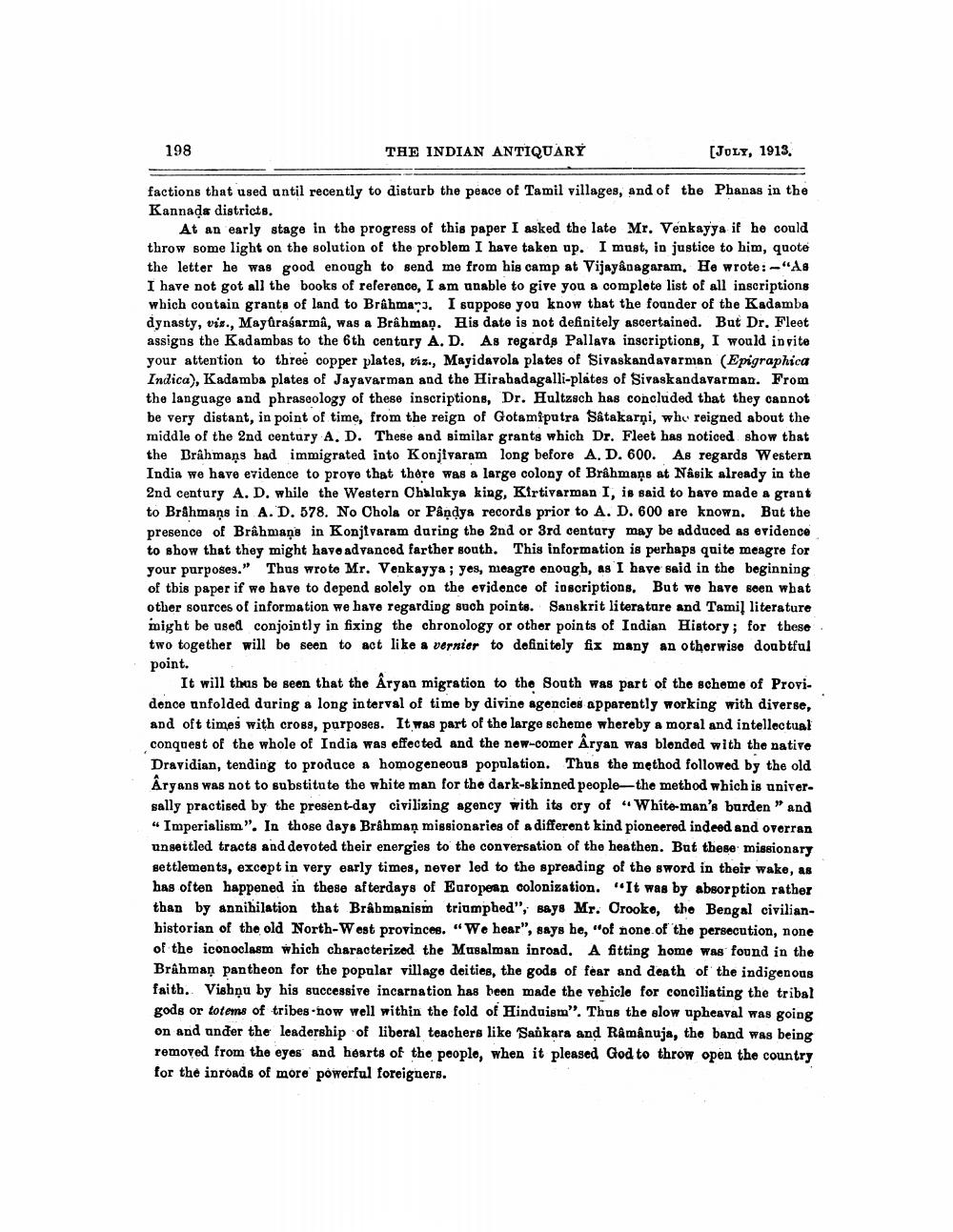________________
198
THE INDIAN ANTIQUARY
[JULY, 1913,
factions that used until recently to disturb the peace of Tamil villages, and of the Phanas in the Kannada districts.
At an early stage in the progress of this paper I asked the late Mr. Venkayya if he could throw some light on the solution of the problem I have taken up. I must, in justice to him, quote the letter he was good enough to send me from his camp at Vijayanagaram. He wrote: -"As I have not got all the books of reference, I am unable to give you a complete list of all inscriptions which contain grants of land to Brahmar. I suppose you know that the founder of the Kadamba dynasty, viz., Mayûraśarmâ, was a Brahman. His date is not definitely ascertained. But Dr. Fleet assigns the Kadambas to the 6th century A. D. As regards Pallava inscriptions, I would invite your attention to three copper plates, viz., Mayidavola plates of Sivaskandavarman (Epigraphica Indica), Kadamba plates of Jayavarman and the Hirahadagalli-plates of Sivaskandavarman. From the language and phraseology of these inscriptions, Dr. Hultzsch has concluded that they cannot be very distant, in point of time, from the reign of Gotamiputra Satakarni, who reigned about the middle of the 2nd century A. D. These and similar grants which Dr. Fleet has noticed show that the Brahmans had immigrated into Konjivaram long before A. D. 600. As regards Western India we have evidence to prove that there was a large colony of Brahmans at Nasik already in the 2nd century A. D. while the Western Chalukya king, Kirtivarman I, is said to have made a grant to Brahmans in A. D. 578. No Chola or Pândys records prior to A. D. 600 are known. But the presence of Brahmans in Konjivaram during the 2nd or 3rd century may be adduced as evidence to show that they might have advanced farther south. This information is perhaps quite meagre for your purposes." Thus wrote Mr. Venkayya; yes, meagre enough, as I have said in the beginning of this paper if we have to depend solely on the evidence of inscriptions. But we have seen what other sources of information we have regarding such points. Sanskrit literature and Tamil literature might be used conjointly in fixing the chronology or other points of Indian History; for these two together will be seen to act like a vernier to definitely fix many an otherwise doubtful point.
It will thus be seen that the Aryan migration to the South was part of the scheme of Providence unfolded during a long interval of time by divine agencies apparently working with diverse, and oft times with cross, purposes. It was part of the large scheme whereby a moral and intellectual conquest of the whole of India was effected and the new-comer Aryan was blended with the native Dravidian, tending to produce a homogeneous population. Thus the method followed by the old Aryans was not to substitute the white man for the dark-skinned people-the method which is universally practised by the present-day civilizing agency with its cry of "White-man's burden" and "Imperialism". In those days Brahman missionaries of a different kind pioneered indeed and overran unsettled tracts and devoted their energies to the conversation of the heathen. But these missionary settlements, except in very early times, never led to the spreading of the sword in their wake, as has often happened in these afterdays of European colonization. "It was by absorption rather than by annihilation that Brahmanism triumphed", says Mr. Crooke, the Bengal civilianhistorian of the old North-West provinces. "We hear", says he, "of none of the persecution, none of the iconoclasm which characterized the Musalman inroad. A fitting home was found in the Brahman pantheon for the popular village deities, the gods of fear and death of the indigenous faith. Vishnu by his successive incarnation has been made the vehicle for conciliating the tribal gods or totems of tribes-now well within the fold of Hinduism". Thus the slow upheaval was going on and under the leadership of liberal teachers like 'Sankara and Râmânuja, the band was being removed from the eyes and hearts of the people, when it pleased God to throw open the country for the inroads of more powerful foreigners.




